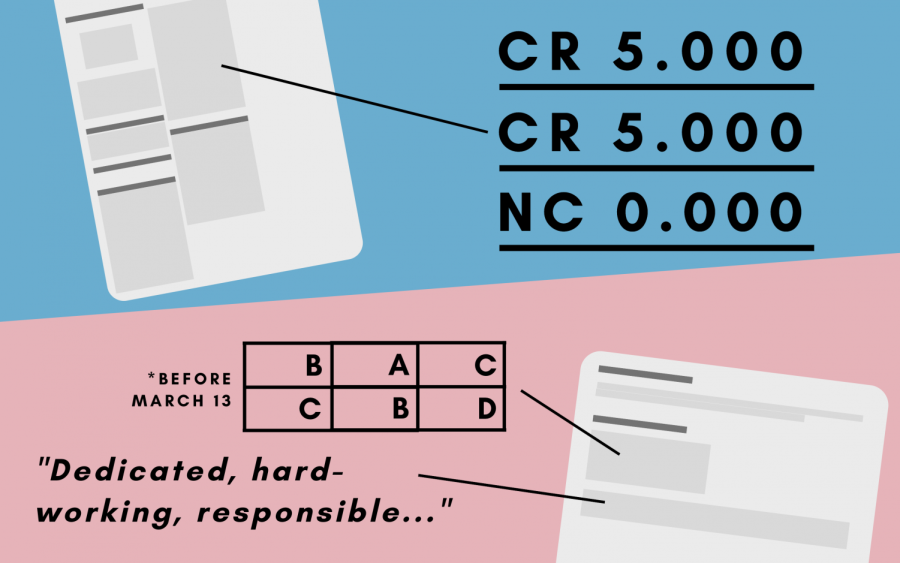Transitioning to credit/no credit for second semester
Graphic illustration by Elena Williams
Transcripts will now look drastically different, following the district’s decision to move to a credit/no credit grading system for the second semester.
May 27, 2020
When quarantine prompted radical changes to the format of school classrooms, FUHSD dropped its traditional letter grades in favor of a credit/no credit grading system. The decision, announced on April 11, immediately generated controversy with strong opinions from the community both in favor and against.
The district reached this decision after consulting many parties, including Intradistrict Council (IDC) representatives from FUHSD schools, the Santa Clara County Office of Education and colleges. Some from these groups and other voices in the community raised several concerns over letter grades and encouraged credit/no credit grades instead.
For one, many students and teachers worried that teachers would find it difficult to evaluate students fairly based on points because exam security is no longer a possibility and the only remaining metrics for performance are completion of assignments and attendance.
“One primary concern was whether we could give a valid grade that truly represented knowledge and skills attainment in a valid way,” said Tom Avvakumovits, FUHSD Associate Superintendent of Teaching and Learning. “I heard from many teachers who said that in this emergency learning environment, [they were] not able to quickly readjust all the various assessments that [they had] planned in a fair way.”
Furthermore, the quarantine has both amplified existing inequities between students and created new ones, as students with limited access to technology and financial support are less likely to do well in their classes. Many students and teachers face greater challenges at home as well — some may have greater household and childcare responsibilities if their families had previously relied on daycare services, for instance. Some now have much more free time, while others have much less, and it has become difficult to evaluate students across different circumstances fairly.
“People got thrown into the shelter-in-place very quickly,” Avvakumovits said. “We have students who have to take care of their little siblings. We have other students who have to go to work because their parents may have been laid off. We were able to provide hundreds of hotspots and Chromebooks for those that needed them, but that [did not happen] overnight.”
However, others argued against credit/no credit in favor of a third option — grade floors. A grade floor system would ensure that students’ grades could go no lower than what they were on March 13, but continued participation and achievement would allow students to raise them. This plan would have maintained letter grades while attempting to account for equity issues.
“I think a lot of IDC representatives were in favor of the grade floor because we are aware that at Lynbrook, Monta Vista and a lot of other schools, a typical student tends to work pretty hard for their grades and will want to continue raise their grades,” said Kanav Tirumala, a Lynbrook IDC representative. “But I think they were worried that grade floors would not engage students in the same way, since some students could stop doing the work for a class altogether if they had an A already.”
Under credit/no credit grading, work completion and attendance are still required for credit for all students. Many teachers now require that students complete all assignments and attend all virtual meetings, while others, especially elective and specialty classes, will employ different metrics.
After the announcement, several members of the FUHSD community reached out to the district asking for letter grades to be restored. Some were concerned that credit/no credit grades would not be sufficient for students to demonstrate their understanding of the material, or that this grading system would negatively impact college admissions. This prompted a second email from FUHSD in response, in which the district noted that many colleges with whom they consulted said that credit/no credit grades would not negatively affect admissions and that University of California schools, among others, had already stated so explicitly.
“I think people were very worried that their son or daughter would be disadvantaged in college applications without grades, and that they would be compared to private schools or school districts nearby like Los Gatos and Saratoga that chose to have grades,” FUHSD Superintendent Polly Bove said. “The truth is, colleges compare our students with other students in our district, not students outside our district, as long as they meet the minimum qualifications. They can’t be disadvantaged for any [grading] decision we make.”
However, the district also attempted to address these concerns with additional options for second semester grade reporting. While an overall semester letter grade will not be offered, a school closure grade report will be provided, reflecting students’ letter grade after the eight weeks of school prior to closure on March 13. Additionally, teachers will give comments about each individual student on the school closure grade report, and many teachers will write more letters of recommendation for rising seniors than in typical years in an attempt to shed light on student performance during the closure. Sending the school closure grade report to prospective colleges is optional.
“We thought that the progress report and additional letters of recommendation would help students show the things that they were able to do to colleges and mitigate this worry they’re feeling,” Bove said. “That was our way of trying to come to a middle ground while we’re still dealing with the equity issues.”
Students are divided on the issue. On one hand, some believe that students should still be allowed to prove their academic ability through letter grades.
“Personally, I would have not wanted to do credit/no credit,” Tirumala said. “For me, my friends and for a lot of people I know, school is where we put the majority of our time and effort every day. I had A’s in most of my classes, and now they don’t mean so much.”
Other students prefer the credit/no credit system, many of whom maintain that it is the only fair and viable way to award grades this semester. There are also some averse to letter grades for other reasons.
“Personally I was relieved,” said junior Ria Chaudhary. “I was sick for three or four weeks before the virus canceled school, so it was really difficult for me to submit work and keep up after [school closure]. I felt like I was under a lot of pressure.”
If quarantine continues through the fall semester or if schools return in a modified format, the district aims to return to letter grading.
“We can’t go a second semester and not give grades,” Bove said. “We will work together [over the summer] with our teachers and find new strategies to assess students over remote learning.”



































































